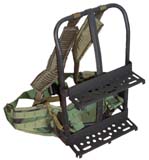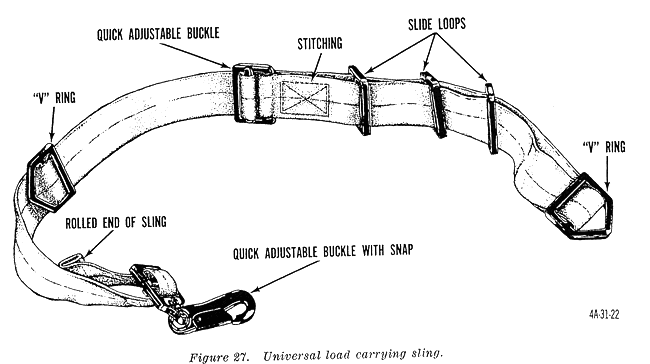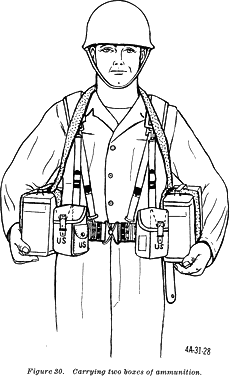Mission Loads: At times it is necessary for you to adjust basic loads and load-carrying equipment to make up for the carry of equipment and supplies required to fulfill your unit mission or to suit your particular assignment. These mission loads are carried by using certain combinations of either lightweight load-carrying systems, the universal load-carrying sling, the plywood packboard, the grenade carrier vest and the various bags. -- FM 21-15, Care and Use of Individual Equipment, 15 February 1977, p. 176.
During World War II the U.S. Army developed the packboard in response to the need for a general purpose system for carrying bulky loads in terrain where wheeled transport could not reach. Packboards had been in use in northern parts of North America for many years and there were many types to examine. A number of designs were tested with emphasis on something that would work for Alpine troops on skis. The "Yukon" design was chosen and refined for Army use.
The Yukon packboard as approved for issue consisted of two narrow wooden uprights across which were fitted close-fitting slats to form a solid surface to support the load. Lashing hooks were placed along the sides, to accomodate loads of varying size and shapes. The board was carried by web shoulder straps fastened near the top. Add-on shoulder pads were available to slip over the straps to make them more comfortable. A canvas strip was between the uprights, toward the body. This kept the board the width of the uprights away from the back, allowing ventilation. The tightly stretched canvas also presented a resilient surface and prevented chafing. The Yukon packboard was found to be generally satisfactory except for its weight.
Experimentation continued and resulted in a new design consisting of a curved body in a broad U shape, with canvas laced across the opening of the U on the body-facing side. The plywood had three openings plus the top where shelf extensions could be clipped in place. One inch web straps with quick release buckles were provided or parachute cord could be used for lashing loads.
The packboard shelf was sized and spaced so three ammo cans could be carried or a single shelf clipped on the bottom rung could be used to carry a jerry can or large iten such as one component of a mortar or machine gun. This design was widely used from World War II through Vietnam, not just for mountain troops but for general use in all services with ground operations, including Special Forces. -- http://www.olive-drab.com/od_soldiers_gear_packboard.php
My favorite bookstore in the world is the Village Bookshop in Linworth, Ohio. I first discovered it decades ago when I lived in Columbus. A discount and remainder bookshop, it has excellent history and military sections where you can save a ton of money versus full price. On my latest trip over Thanksgiving, I picked up a couple of British trade-paperback-sized picture books on the Israeli Army: Uniforms Illustrated No. 12, Israeli Defence Forces 1948 to the Present by Lee Russell and Sam Katz, Arms and Armour Press, 1985 and Uniforms Illustrated No. 17, Israeli Elite Units by Sam Katz, same publisher, 1987.
While I bought them mostly because of the excellent images of the variety of Israeli helmets (for a future praxis I will call "Cabbage Patch Militia"), I was also interested to see numerous photos of the plywood US army packboard as used by the Israelis in all their wars from the 1948 War of Independence to the 1982 incursion into Lebanon carrying everything from radios and ammunition boxes to folding stretchers and improvised tactical racks for 3.5" bazooka rockets, RPG projectiles and rifle grenades. (The packboard is rated by FM 21-15, Care and Use of Individual Equipment, 1977 edition, as capable of loads up to 100 pounds.)
The Israelis became fond of the USGI packboard early in their history. In O Jerusalem!, Larry Collins and Dominique LaPierre describe the December 1947 mission of Haganah military goods buyer Xiel Federmann in Antwerp, Belgium. Bribing his way into a huge depot of US military surplus goods with a Christmas present of cognac,
Federmann began to survey the immensity of the display before him, preparing his shopping list for the soldiers of his still-unborn country. In one of the first warehouses he entered, he stumbled on a strange device. It was a US Army pack rack designed to help a man carry a heavy load. Federmann hesitated for a moment. They might be useful, he thought, and they cost only twenty cents apiece. With a shrug, he marked three hundred down on his list and walked on. One day, Federmann's twenty-cent pack racks would save the Jews of Jerusalem from starvation. -- O Jerusalem!, page 121.
When the packboards arrived at the port of Haifa aboard the S.S. Isgo just after the British departed, they were mixed in with a larger cargo of two dozen US M-3 half-tracks.
The dockers of the port . . . looked with rising incredulity at the pile of pack racks they had pulled from the the cargo hold . . . and wondered what contribution they could possibly make to the country's war effort. -- Ibid., page 477.
By the time the S.S. Isgo docked, the Jews of Jerusalem were under siege and starving. Every attempt to supply them by existing road had been bloodily defeated. A new road, plotted out by former American Army Colonel David Marcus and dubbed the "Burma Road," was being constructed through the hills to avoid the Arab strongpoints. But with only two bulldozers and unskilled volunteers, the Jewish Quarter in Jerusalem would fall before it was completed.
There was no question of waiting for the Burma Road. Ben-Gurion summoned his closest collaborators to find a way of nourishing the famished city. There was only one. Three miles of steep ravines and sharp inclines separated the farthest point to which Marcus had been able to push his bulldozers and the point to which vehicles coming down from Jerusalem could penetrate into the hills. Since it was totally impossible to push a truck through those three miles, the survival of Jerusalem's one hundred thousand Jews would have to entrusted to another form of transport, the most ancient in the world: two marching feet.
Ben-Gurion's experts calculated that if they could round up six hundred men and march them through the darkness each night over those three miles of terrain with a forty-five pound sack on their backs, they might get enough food across the hills to save the city. . . Most of (the packers) shared two characteristics. They were city dwellers and had rarely walked more than half a mile at a time. They were middle-aged or older; the legs and backs which would have to nourish Jerusalem were all close to retirement age.
The buses took them to Kfar Bilu . . . The camp was already brimming with activity when they arrived. Called in haste from the nearby kibbutzim, women were frantically stuffing flour, ice, sugar, dried vegetables and chocolate into the sacks the men would carry.
Their leader, Joseph Avidar, gathered them for a briefing on the job ahead. As he spoke, he began to see signs of fear and doubt creeping into the faces of some. The Russian miller's son who had lost a hand making grenades for the Haganah stalked up closer. In a voice hoarse with emotion he told the men before him that the entire ration distribnuted to their brothers in Jerusalem that morning had consisted of four slices of bread. Pointing dramatically to the pile of sacks awaiting them, he proclaimed, "Each of you is going to carry on your back the food to keep a hundred Jews alive another day."
Avidar had one more surprise. The three hundred pack racks Xiel Federmann had bought for twenty cents almost as an afterthought on Christmas day in Antwerp had found at last a utilization. Avidar ordered the hastily mobilized men to lash their sacks to a rack and get back into their buses. They were off to the hills of Judea. -- Ibid., pp. 551-552
This human pack train of determined, out-of-shape older men kept the Jews in Jerusalem resisting until the Burma Road was completed and a ceasefire was declared. Some died of heart attacks, others fell off precipices, and all left their blood and flesh on the sharp rocks. Some made it on their hands and knees. But they made it. And in doing so they saved Jerusalem's 100,000 Jews. Federmann's sixty dollars had been well spent.
The US Army quit procuring packboards after Vietnam and they are no longer used by the modern, air and land vehicle-borne logistics of the 21st Century military.
Today, USGI packboards are collector's items. I know, for I have collected about twenty of them over the past fifteen years. Most of these are stored today in silicone-sealed plastic storage tubs or steel drums in caches scattered across Winston, Blount and St. Clair counties in Alabama. Some of them were purchased for as little as $1.98 in thrift stores, and although I have been given a couple by folks who viewed them as "useless clutter," I've never paid twenty cents for one. Each is packed with a little booklet in a zip-lock bag, crafted of xeroxed pages of the 1977 edition of FM 21-15, pp 161-175, containing instructions for their use and maintenance. They may one day come in handy.
Here's a World War II packboard manual from www.olive-drab.com: http://www.olive-drab.com/od_soldiers_gear_packboard.php
There is, however, a more modern alternative to the packboard that is readily available: the USGI ALICE pack frame with cargo shelf.

I have picked up about three dozen of these over the years, also scattered about in caches along with the supplies they are designed to carry. They too have instruction manuals in zip-lock bags, xeroxed from the 1977 edition of FM 21-15, pp. 108-113 and 115-117. The load limit of the ALICE frame with cargo shelf is similar to the packboard (50-100 pounds).

The Universal Load Carrying Sling
In the same caches, I have stored about 50 Universal Load Carrying Slings, each in its own zip-lock bag with an instruction book made up of pages 153 through 160 of the same manual, illustrating how one man may use the strap to carry up to 35 pounds of crew-served weapons ammo in tubes, ammunition boxes, five gallon water cans or rations. Four men may also use them to sling a stretcher. (You can find these manual pages posted at HardScrabbleFarm: http://www.hardscrabblefarm.com/vn/ulcs.html ).

Examples of each of these systems: the packboard, the ALICE cargo frame and the Universal Load Carrying Sling are still available in Army surplus stores (and other sources) for purchase by small militia units to enhance their ability to sustain themselves over rough country or where vehicle-borne supplies are problematic. The time may come that the only way you can resupply is by "shank's mare." If that time arrives, you will wish you had stocked up on these simple but essential mission load systems.
9 comments:
The pics you posted from the old packboard manual won't show up. Availability aside I think I would prefer an alice frame...a kidney pad, when you pack the pack properly (heavy stuff near the small of your back to take strain off your shoulders and help with your center of gravity) goes a long way to making a heavy load suck less.
Glad to have you back posting good info again!
I've got two of the packboards. I know a lot of others that have them. They are prized, up here in Montana, for packing out big game. One of my packboards has been modified with a waist belt. It is the one I prefer when packing out an elk quarter.
Good info Mike.
We shall add to our caches.
Skip 111
Hope you are recovering well. If the Doc says it's OK, have glass.
It will be on me, when we meet.
the pic of the load carrying gear didn't upload. or so I guess the squares are blank.
good article.
We used them in scouts in the 70's as well. for carrying the chuck boxes for our patrol at summer camp.
r
SO glad to see you back!
I noticed just minutes before reading this that military dot com has the ALICE-pack shelves for 80 cents!
HTH!
God Save Our Republic!!
Any frame from an external frame pack can be used the same way...with a LOT more comfort than the old packboards.
Even high-end internal frame manufacturers like Mystery Ranch and Kifaru have similar options using their suspension systems.
And the ALICE frame doesn't fit most people well at all. Yes, we all carried one over hill and dale and suffered...19 year olds will put up with a lot of crap. Old folks can't so much. Get decent (aftermarket) shoulder, back and kidney pads, and a good waist belt for the Alice frame. I recommend Tactical Tailor gear for this (They also turn the Alice bag into something useable) - and I have no connections with them.
i served with the 101st.airborne in viet nam 1968 and our alice packs weighted 120lbs. the way we carried them was with the large nylon bag attached at the top of the frame with the lower part used to carry your poncho and liner or an ammo box.to make the frame easier on our backs we would put c ration card board in the back so we did not get cans or grenades poking us in the back.the card board will mould its self to you and make it a little easier to carry.nothing could stop the weight from making your shoulders from becoming numb or you back from hurting.
Interesting you mentioned StClair county. I was just there on business.
Didn't find any caches :-))
Post a Comment